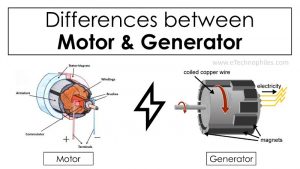Last updated on March 23rd, 2024 at 01:15 pm
Motors and generators are two of the most popular electrical machines used in an electrical system. There might be many differences between a motor and a generator, but their construction is almost similar. The main difference between a motor and a generator lies in energy conversion. While a motor converts electrical energy to mechanical energy, the generator does the opposite.
In this article, we will discuss all the differences between a motor and a generator in detail. So, to know them all, keep on reading this article till the end.
Differences between a motor and a generator in tabular form
Starting from the principle of operation to their respective application. This table covers all the key differences between a motor and a generator.
| MOTOR | GENERATOR | |
|---|---|---|
| Definition | An electric motor is a machine that converts electric energy to mechanical energy. | An electric generator is a machine that converts mechanical energy to electric energy. |
| Working Principle | A current-carrying conductor placed in a magnetic field experiences a force. | The rate of change of flux linkage in a conductor creates an EMF (Electromotive force). |
| Fleming’s rule | It follows Fleming’s left-hand rule. | It follows Fleming’s right-hand rule. |
| Types | Electric motors are of two types: AC motor and DC motor. | Electric generators are of two types: AC generators and DC generators. |
| Function | Its function is to provide mechanical force. | Its function is to provide electricity. |
| Representation | The letter ‘M’ represents an electric motor. | The letter ‘G’ represents an electric generator. |
| The direction of current flow in Armature | Armature windings require current from an external source. | Armature windings produce current and send it to an external load. |
| Input to the machine | The motor requires input in the form of an electric current. | The generator requires input in the form of a mechanical force. |
| Source of energy | Power grids & electrical supply | Turbines (water & steam) and engines |
| Output from the machine | The motor gives output in the form of mechanical force. | The generator gives output in the form of electricity. |
| Electricity | It uses electricity. | It produces electricity. |
| Back EMF | There is a production of back EMF. | There is no production of back EMF. |
| Application | Fans, blowers, pumps, etc. | Power stations, charging batteries, etc. |
Table of Contents
Differences between a motor and a generator in detail
After a quick glimpse of all the differences, it is time to understand each one of them in detail.
Let us start our explanation with their definitions.
Definition
There are numerous ways to define a motor and a generator. But, their precise definition goes like this:
Motor:
An electric motor is a machine that converts electrical energy to mechanical energy.
Generator:
An electric motor is a machine that converts electrical energy to mechanical energy.
Working principle
Motor:
When we place a current-carrying conductor in the magnetic field, it experiences a force. This force rotates the motor shaft and provides mechanical energy.
Generator:
When we place a current-carrying conductor in the magnetic field, it experiences a force. This force rotates the motor shaft and Whenever the magnetic flux linking with a coil changes, an EMF (electromotive force) gets induced across the coil ends. Creating a closed path leads to the flow of induced current.
Fleming’s rule
Magnetic field, force, and current are the three parameters that are common to both machines.
In an electric motor, we know the direction of the magnetic field and the current flow direction in a conductor. So, to find the direction of magnetic force, we use Fleming’s left-hand rule.
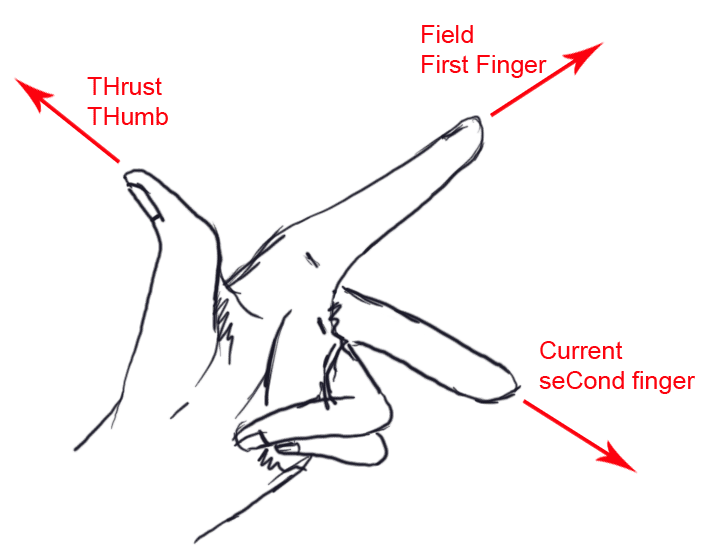
In an electric generator, we know the direction of magnetic force and field in a conductor. To find the direction of induced current, we use Fleming’s right-hand rule.
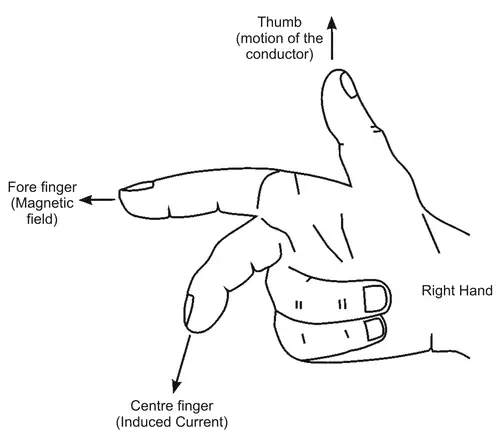
Types
Based on the source nature, the electric motor is of two types. These are AC motor (Synchronous & Induction motor) and DC motor (Series, shunt & compound motor).
The electric generators are also of two types. These are AC generator (Synchronous & Induction generator) and DC generator (Separately excited & self-excited).
Inputs to the machine
Motor:
In an electric motor, the magnetic field is already present. To create the mechanical force, we have to supply electric current. Power grids or generators are the source of electric current to the motor.
Generator:
In an electric generator, to find the direction of induced current, we have to provide an eternal force to rotate the shaft, and hence the conductor. Steam turbines, water turbines, or combustion engines provide this mechanical force to the generator.
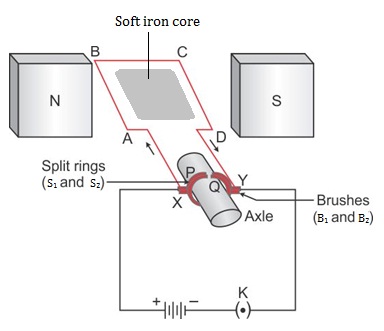
Outputs from the machine
Motor:
The output of the electric motor is the mechanical force.
Generator:
The output of the generator is electricity. It can either be AC (Alternating current) or DC (Direct current), depending on the type of generator.
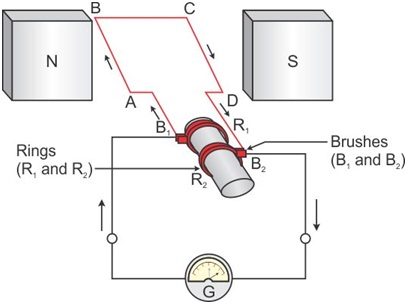
The direction of current flow in armature
Motor:
In an electric motor, the current flows to the armature windings. The carbon brushes collect the current from the external source and supply it to the armature conductors to produce mechanical force.
Generator:
In a generator, the current gets induced in the armature windings. The carbon brushes collect the current from the armature windings and supply it to the external load connected to the generator.
Application
Motor:
Electric motors find applications in homes, offices, and industries. Fans, blowers, pumps, elevators, mixer grinders, drilling machines, cranes, and hoists use electric motors.
Generator:
The prime function of the generator is to generate electricity. Hydroelectric power stations, Steam power stations, and nuclear power stations use electric generators. Generators are also used in charging batteries in industries.
These are the main differences between a motor and a generator. We hope this article might have given a better understanding of the motor and the generator. If you still have any doubts, ask them in the comment section below.
